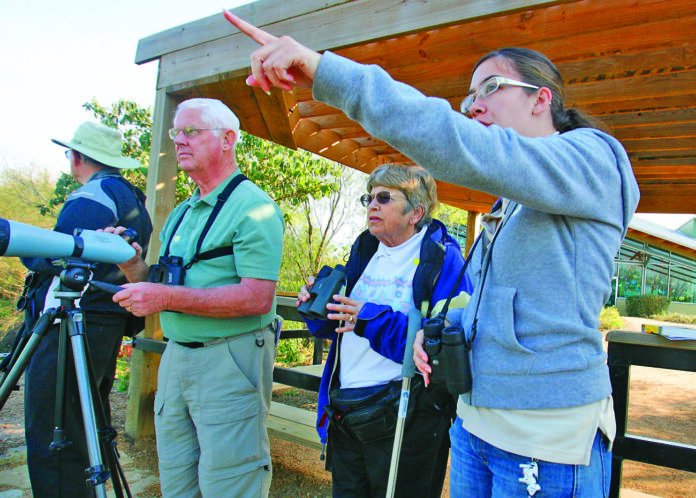What was nearly a year of hand-wringing over whether to sell land at a local birding preserve to the government for wall construction, came to a head Friday in an emergency meeting and a subsequent decision to walk away from the deal.
Attorneys for a local birding preserve submitted a document to the internal counsel for the U.S. Army Corps of Engineers on Friday afternoon, notifying them of their withdrawal of an agreement to sell roughly 2.5 acres of land at the preserve, their executive director said Monday.
The letter, sent by Valley Land Fund’s attorneys, notified the government of the longtime organization’s intent to withdraw from the agreement to sell the land in Salineño, Texas, known around the world for the birding preserve located there.
Debralee Garcia-Rodriguez, the executive director, said she took issue with U.S. Customs and Border Protection officials who confirmed the sale of the land in a news release on Nov. 6. Stating that though an agreement was in place, the sale was not final as no money or deed had been exchanged.
OCTOBER DECISION
She said the board agreed in late October — 11 votes to 1 — to sell the land in what she said was the hardest decision the board has had to make in nearly a decade.
The decision came after nearly a year of discussions about what to do with respect to the government’s attempt at land acquisition at the birding center.
She said the board is made up of people on different sides of the political spectrum, but said she believed the board made its decision based on what was in the best interest of the preserve and not based on personal politics.
On Friday, a day after news of the sale broke and amid public outcry, Valley Land Fund’s board of directors — which is composed of four officers and eight members — convened with attorneys via Zoom to once again discuss the sale, ultimately leading to the vote reversing the late October decision.
It’s important to note that Garcia-Rodriguez, who has been the target of attacks online after word of the decision was made public, does not have a vote and is tasked with executing the decisions made by the board of directors. She has been the executive director with the conservation group since 2012.
The lifelong nonprofit executive and Rio Grande Valley native said the initial decision to sell the land, which was more than 10 months in the making — was a long, and difficult decision, that was only made after taking stock of all options available and after numerous attempts to delay the U.S. Army Corps of Engineers’ efforts to close a deal on the land.
INITIAL CONTACT
She said government officials first made contact with the preserve in January, after government officials identified a portion of land they wanted to use for the construction of an enforcement zone, related to construction of a border wall.
“…(Government officials) wanted a small sliver of land, a portion of the property, the most valuable of the tract, It’s actually where our caretakers, (U.S. Fish and Wildlife staff) reside, and all the action, the birding action happens,” the executive director said.
Garcia-Rodriguez said after pushing back on selling even this sliver of land, roughly less than an acre in size earlier in the year, U.S. Army Corps of Engineers officials made it clear to VLF that they would eventually pursue a lawsuit to condemn the land and take it from the preserve.
The preserve’s executive director said after considering everything that would go into not selling to the government, including the legal ramifications, resources on hand, the fact that the adjacent land was government-owned, and the organization’s long standing core mission — to preserve beautiful lands in the Rio Grande Valley — they felt selling the land to the government was the best path to continuing the group’s main mission.
“The sense was that if the U.S. government was going to take our land, they were going to take our land,” she said. “But if you’re going to take (our) land, you’re going to have to pay for it. If the sale would have gone through, that would have been a very sad day for everybody.”
Garcia-Rodriguez said that although they recognized the utter disappointment of having to sell what she characterized as a “special piece of land” to the government, the thinking at the time was they would use the money from the sale to find another piece of land that would not be behind a barrier, and help continue the organization’s legacy.
NEXT FIGHT
On Saturday, when asked about the preserve’s intention to walk away from the land deal, a CBP spokesperson said they had not yet received any formal communication related to the board’s decision.
Garcia-Rodriguez said she expects the government to file a condemnation lawsuit against the land by the end of the week, but is hopeful that President-elect Joe Biden’s approach on infrastructure construction ends the current situation they’re in.
Biden has promised not to build additional wall barriers, and migratory experts have said it is possible the government, once Biden is in office, walks away from land acquisition lawsuits as they would no longer need the land for border wall construction.
In addition to receiving personal attacks after the report of the sale to the government, the executive director said they also received messages of support and offers of help from preservation organizations and conservationists.
That support, Garcia-Rodriguez said, helped the board in its decision to reverse course Friday.
She said now more than ever, the small conservation organization will need the support of the community in its fight against the government.
“It was a tough decision, and it’s going to be a big fight,” Garcia-Rodriguez said. “We will need the help of the community to rally behind us to make sure we can win this fight, because we need it.”




